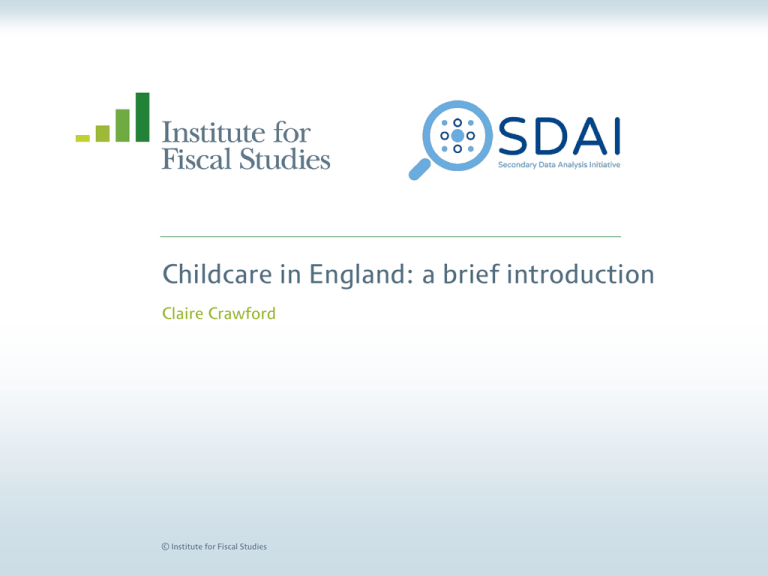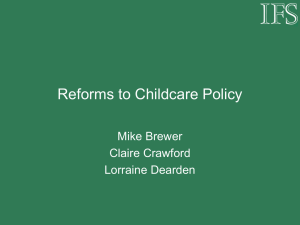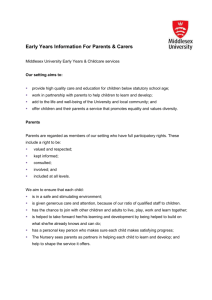Childcare in England: a brief introduction Claire Crawford
advertisement

Childcare in England: a brief introduction Claire Crawford © Institute for Fiscal Studies Introduction • Public support for childcare receiving increasing attention from policymakers as a potential tool to: – Promote child development – Encourage parents (particularly mothers) into or back to work – Reduce socio-economic inequalities • Evidence on the effectiveness of early years interventions as a means of promoting child development has a long history – Though less evidence on what works for disadvantaged children • But international evidence on the extent to which a significant causal relationship exists between childcare availability or use and mother’s labour supply is mixed – Effects difficult to identify in the absence of policy variation © Institute for Fiscal Studies Aim of today is to provide you with . . . • A picture of how public support for childcare works in other countries and how this compares to the UK • Some insight into the international evidence on childcare and its effects on child development and maternal labour supply • An understanding of the challenges facing the UK in terms of childcare policy going forwards and some expert insight into the ways in which it might best face these challenges • My introduction (focusing on 3-4 year olds in England): – How the government supports childcare/early education – Free early education for 3 and 4 year olds: take-up and effects of provision on child development and mother’s labour supply – First stab at summarising challenges for UK policymakers © Institute for Fiscal Studies Overview © Institute for Fiscal Studies Public support for childcare in England Type of support For whom? Details of entitlement Estimated cost (p.a.) Direct provision Universal 15 hrs/wk of free early education for 3 and 4 yr olds. Can in principle be taken 7am-7pm over a min. of 2 days/wk, up to 52 wks/yr, but relies on providers offering flexibility. £1.9 billion (NAO,2012) Meanstested From Sept 2013: entitlement extended to 20% most deprived 2 yr olds (looked after children or those entitled to free school meals); to be extended to 40% most deprived in Sept 2014. £341 million (DfE, 2012b) Universal (Though must work for a participating employer.) No income tax or employee/employer NICs on first £55/wk (£2,860/yr) of employer-provided childcare vouchers for basic rate taxpayers (£28/wk for higher rate taxpayers). £800 million (HMRC, 2013) Meanstested Working tax credit recipients (families where each parent works 16 or more hours per week) can claim up to 70% of spending on formal childcare up to a cap of £175/wk for one child or £300/wk for more than one child. £1.3 billion (HMRC, 2012-13) Financial support © Institute for Fiscal Studies Percentage of working families using different types of childcare for pre-school children over time 100% 90% 80% 70% 60% 50% 40% 30% 20% 10% 0% Any type of childcare Formal childcare 1999 Source: Table 3.9 of Bryson et al. (2012) © Institute for Fiscal Studies 2004 2008 Informal childcare Key questions • To what extent does support for childcare in general increase take-up of formal childcare, childcare overall and parental (especially maternal) labour supply? • Are some policies or methods of finance more effective than others at achieving these aims? • To what extent does universal provision offer value for money? – Could similar take-up be achieved amongst children from disadvantaged backgrounds using means-tested provision only? • Evidence suggests that access to high quality provision is what matters: to what extent can the government further incentivise the supply of and demand for high quality provision? © Institute for Fiscal Studies Free early education for 3 and 4 year olds © Institute for Fiscal Studies Routes through which entitlement can be taken Type of care Providers Ages catered for Formal Schools © Institute for Fiscal Studies Hrs/wk Wks/yr Cost of other care 4 year olds: Nursery classes Reception classes Free p/t f/t Term-time (approx. 38 wks/yr) State-run nurseries 3-4 year olds f/t or p/t Term-time Free Sure Start Children’s Centres 0-4 year olds f/t or p/t Year round Means-tested fees Private/voluntary-run nurseries 0-4 year olds f/t or p/t Year round Fees Childminders 0-4 year olds f/t Year round Fees What proportion of 3 and 4 year olds take up their free entitlement and where? 3 year olds 4 year olds 93% of 3 year olds and 98% of 4 year olds benefitted from some free early education in 2012 Private and voluntary providers Private and voluntary providers Nursery schools and nursery classes Nursery schools and nursery classes Infant classes in primary school Infant classes in primary school Private schools Private schools Not benefitting from free early education Not benefitting from free early education Source: DfE (2012a) © Institute for Fiscal Studies But not all children take up their full entitlement . . . 3 year olds 4 year olds 89% of PTE places for 3 year olds and 93% of PTE places for 4 year olds were filled in 2012 0-2.5 hours 3-5 hours 0-2.5 hours 3-5 hours 5.5-7.5 hours 8-10 hours 5.5-7.5 hours 8-10 hours 10.5-12.5 hours 13-15 hours 10.5-12.5 hours 13-15 hours 15.5-22.5 hours 23-25 hours Source: DfE (2012a) © Institute for Fiscal Studies Further details of funding model for entitlement • Funding for free early education places provided to LAs via the Dedicated Schools Grant (DSG), but not ring-fenced – % of DSG spent on early education varies from 3.5% to 9.8% • LAs determine their own funding formulae: – Must reward providers catering for disadvantaged pupils – Can additionally reward quality and flexibility – Variation in inclusion/exclusion of these factors and weights attached • NAO (2012): some evidence that deprived areas and those with higher local wages spent more of their DSG on early education – But none that higher spending is related to higher take-up/quality © Institute for Fiscal Studies How does 3 year old take-up vary by area? • Take-up is lowest (70-90%) in urban areas, especially London, Manchester and Birmingham • Partly composition: ethnic minorities and those from more deprived backgrounds are less likely to take up their places • Possibly also supply constraints Source: DfE (2012a) © Institute for Fiscal Studies Which pupils have access to high quality care? • Nursery schools tend to be of highest quality: – 96% rated as good or outstanding by Ofsted compared to 75-80% of nursery classes and private/voluntary/independent providers • Children from more deprived backgrounds more likely to attend nursery schools, hence can access high quality care via this route – But attend lower quality schools on average than those from less deprived backgrounds (Gambaro, Stewart and Waldfogel, 2013) • And average quality of providers is higher in less deprived areas (though not by much) © Institute for Fiscal Studies What is the effect of this policy likely to be on child development and mothers’ labour supply • Could increase use of formal childcare but lead to an equivalent reduction in informal care → no overall change in total childcare – Might affect child development but unlikely to affect labour supply • Could increase use of formal childcare and result in a smaller reduction in informal care → overall increase in childcare – Might affect child development and mothers’ labour supply (positively or negatively) © Institute for Fiscal Studies Effects on child development • No evidence of effect of this specific policy on child outcomes • But plenty of evidence that using formal childcare (especially high quality care) is good for children’s attainment and wider skills – e.g. EPPE study continues to show positive effects of care and especially high quality care on educational attainment at age 14 – Goodman & Sianesi (2005) showed that effects persist into adulthood • Increases educational attainment and likelihood of being employed • 3-4% wage gain amongst those in work at age 33 © Institute for Fiscal Studies Effects on mothers’ labour supply • Children become eligible for free provision in term after turn three • Means children born just before the start of term become eligible for nursery four months earlier than children born just after • Brewer & Crawford (2010) use this variation to identify effects of eligibility for nursery on labour supply of low income lone parents • Find some evidence of a small but significant positive effect – Lone parents whose youngest child is eligible for free early education are 1.7 percentage points (around 10%) more likely to be off benefit © Institute for Fiscal Studies Ongoing work will feed into this debate (1) • Joint work between IFS, ISER and CLS will: – Extend this analysis to consider the labour supply of other parents too – Investigate whether differential access to nursery education arising from these discontinuities affects subsequent educational attainment • In addition it will: – Use geographical variation in access to nursery places in the 1990s to investigate effects on child development and mothers’ labour supply – Investigate similar effects of eligibility for childcare element of WTC • For more details, see: – https://www.iser.essex.ac.uk/projects/the-effect-of-free-childcare-on-maternallabour-supply-and-child-development – http://www.cls.ioe.ac.uk/page.aspx?&sitesectionid=1199&sitesectiontitle=Evaluati ng+the+impact+of+nursery+attendance+on+children%E2%80%99s+outcomes © Institute for Fiscal Studies Ongoing work will feed into this debate (2) • Other ongoing work at IFS will also feed into this debate, e.g. – Impact of access to Sure Start Children’s Centres on educational attainment using administrative data – Impact of access to high quality provision (relative to no provision and low quality provision) on Key Stage 4 attainment; use to make formal assessment of value for money of (high quality) nursery provision • This package of work should help to address important questions: – Impact of universal entitlement to nursery education on child development and mothers’ labour supply, and how does it vary? – What is the effectiveness of direct provision vs. financial support? – How important is quality? © Institute for Fiscal Studies Summary • Big expansion in spending on and access to formal childcare • Take up and quality still at least somewhat variable • Funding system complex and expensive • Surprisingly little good evidence on effectiveness in promoting employment © Institute for Fiscal Studies Ongoing challenges • Policy challenges: – Improve and simplify funding system – Clarify objectives – Ensure take up and access to high quality provision • Evidence challenges: – What are most (cost) effective funding systems? • Balance between supply and demand subsidies – Impact of different policies on: • Parental labour supply • Quality of provision and long-term child outcomes © Institute for Fiscal Studies References • Brewer & Crawford (2010), Starting school and leaving welfare: the impact of public education on lone parents’ welfare receipt, IFS Working Paper W10/19. • Bryson, Brewer, Butt & Sibieta (2012), The role of informal childcare: A synthesis and critical review of the evidence, Report to the Nuffield Foundation. • DfE (2012a), Provision for children under five years of age in England: January 2012, Statistical First Release SFR13/2012. • DfE (2012b), Impact Assessment of Two Year Olds' Entitlement to Early Education, May 2012. • Gambaro, Stewart & Waldfogel (2013), Equal access to high quality early education and care?, Presentation to the Nuffield Foundation, March 2013. • Goodman & Sianesi (2005), Early education and children's outcomes: low long do the impacts last?, Fiscal Studies, Vol. 26, pp. 513-548. • HMRC (2012-13), Child and Working Tax Credit Statistics, December 2012 and April 2013. • HMRC (2013), Main tax expenditures and structural reliefs, HMRC ready reckoners. • NAO (2012), Delivering the free entitlement to education for three- and four-year-olds, Report by the Comptroller and Auditor General, HC 1789, Session 2010–2012. © Institute for Fiscal Studies




